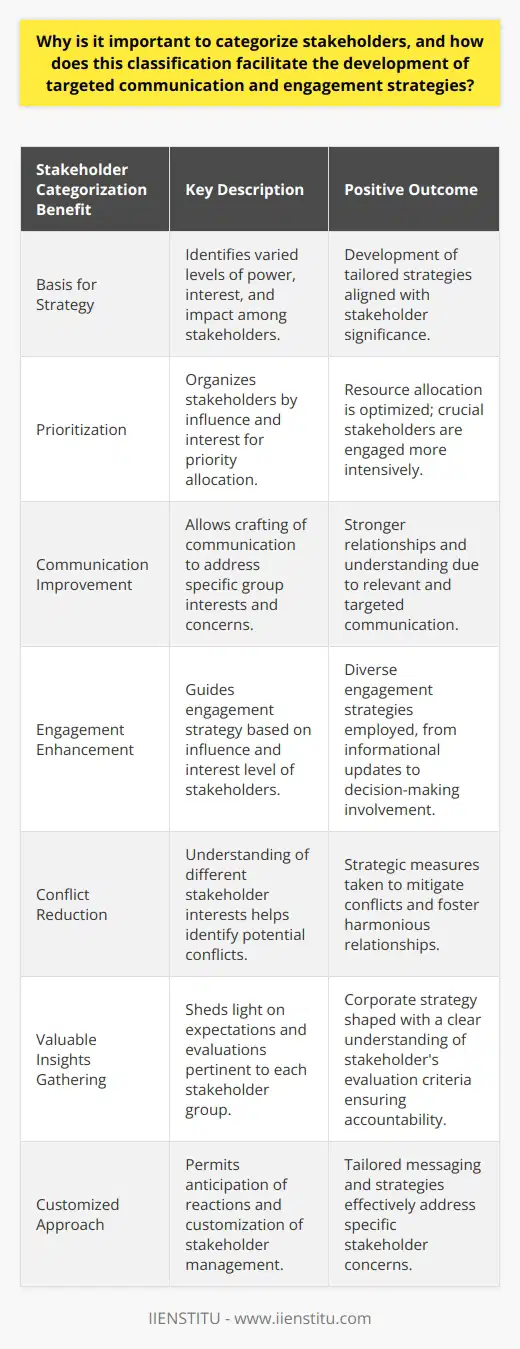
The TIPS framework is a three-step process that begins with the team, consider impacts, and includes subject experts. It is important to consider each category separately and understand who the stakeholders are and how to best work with them.
Introduction
The TIPS Framework
Team
Impacts
Subject Experts
The TIPS Framework for Stakeholder Management
Stakeholder management is an integral part of any successful project. It is essential to understand who the stakeholders are and how to best work with them. The TIPS framework is a way to categorize stakeholders to ensure that all stakeholders are considered, and their roles in the project are understood.
The TIPS framework is a three-step process that begins with the team. The team includes anyone directly involved in the project, including employees and contractors. The next step is to consider impacts, which include any stakeholders impacted by the project but not part of the team. This could include customers, suppliers, and partners.
The final step is to consider Subject Experts, which includes any stakeholders who are experts in the subject matter, even if they don’t have the power to make decisions. This could include consultants, academics, and other professionals.
When using the TIPS framework, it is essential to remember that each category should be considered separately. For example, if your Finance team has the final say on paying royalties, they are Power Players. However, if they don’t have that power, you may still want to include them in their capacity as Subject Experts.
The TIPS framework effectively ensures that all stakeholders are considered, and their roles in the project are understood. It is essential to understand who the stakeholders are and how to best work with them to ensure the success of a project. The TIPS framework can help you categorize your stakeholders for better management and ensure that all stakeholders are considered, and their roles in the project are understood.
Leadership is not just about leading but also about understanding and categorizing your stakeholders.
Related Course: Leadership Development Course
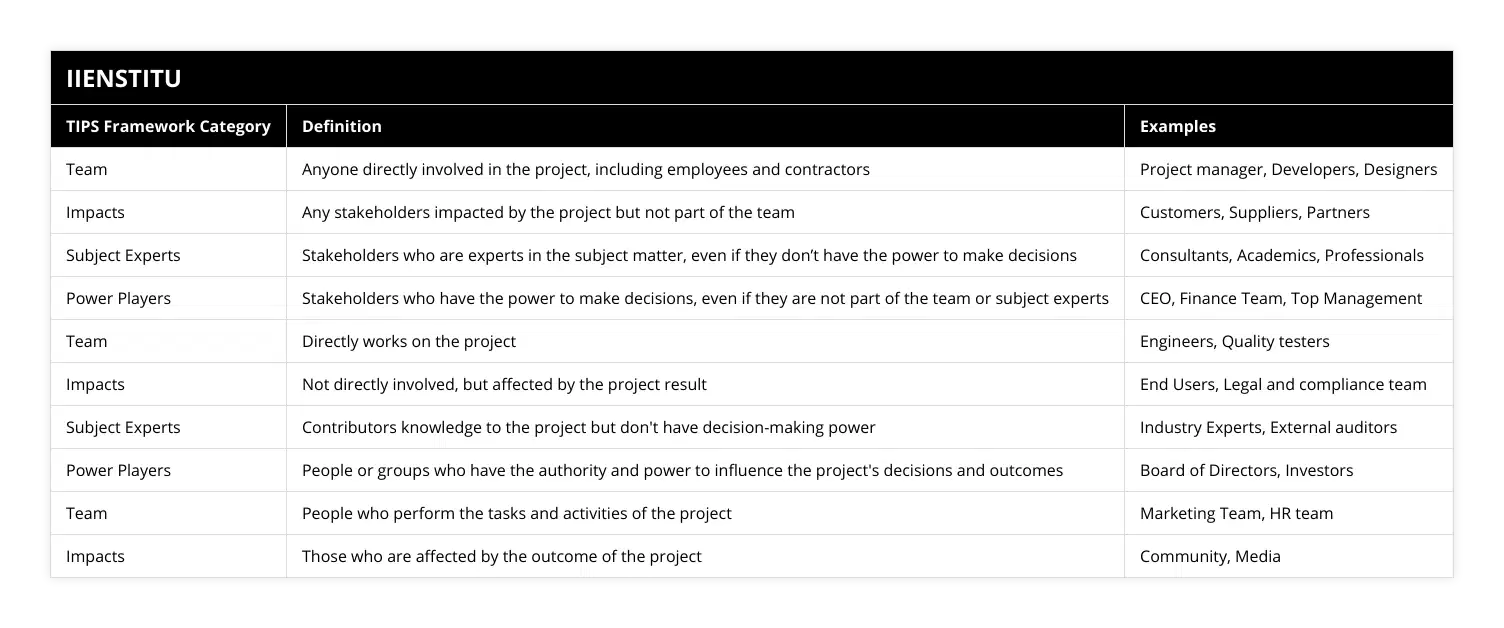
Frequently Asked Questions
What is the TIPS framework and how can it help me categorize my stakeholders?
The TIPS framework is a stakeholder management tool created by the American Society for Quality (ASQ) that provides a systematic approach to stakeholder categorization. It is based on the acronym TIPS, which stands for Task, Interest, Power, and Style. The TIPS framework helps organizations and individuals identify and classify stakeholders according to their specific needs and interests.
To begin with, the Task dimension of the TIPS framework assesses each stakeholder’s contribution to the project. Stakeholders may be categorized according to how much work they require, how significant their contribution is, and the level of commitment needed for the successful completion of the project. This helps organizations and individual stakeholders to prioritize tasks more effectively and understand the roles and responsibilities of each stakeholder.
The Interest dimension assesses each stakeholder’s interests. This helps organizations and individuals identify and prioritize the interests of stakeholders most relevant to the project. The Power dimension assesses the influence of each stakeholder over the project. This helps organizations and individuals to understand the level of influence each stakeholder has and how they can best be managed.
Finally, the Style dimension assesses the communication style of each stakeholder. This helps organizations and individuals to understand the type of communication that is most effective for each stakeholder. This helps organizations and individuals develop communication strategies tailored to each stakeholder’s needs and interests.
Overall, the TIPS framework provides a systematic approach to stakeholder categorization. By assessing the Task, Interest, Power, and Style of each stakeholder, organizations, and individuals can better prioritize tasks, understand the roles and responsibilities of each stakeholder, and develop communication strategies tailored to each stakeholder’s needs and interests. This helps ensure that projects are successful and stakeholders’ interests are met.
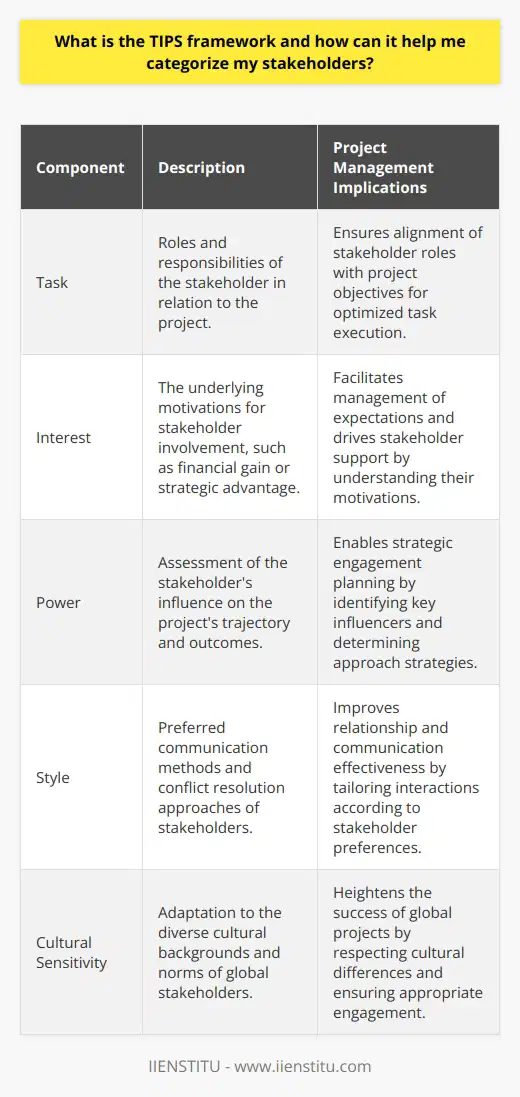
What are the different categories of stakeholders in the TIPS framework?
The Triple I P S (TIPS) framework is a widely accepted organizational model used to identify and prioritize stakeholders in a project. This framework categorizes stakeholders into three distinct groups: Internal, Instrumental, and Power/Political Stakeholders (TIPS).
The Internal stakeholder group consists of individuals or groups within the organization who are directly affected by the project, including employees, owners, and customers. This group of stakeholders has an immediate interest in the success or failure of the project and can provide valuable insight into how the project should be managed.
The Instrumental stakeholder group consists of individuals or groups who are not directly affiliated with the organization but are involved in the project in some capacity. This could include suppliers, subcontractors, and consultants who provide resources and/or services to the project.
The Power/Political stakeholder group consists of individuals or groups who have the power to influence the project's outcome. This could include government agencies, unions, and industry associations. Although these stakeholders may not have a direct interest in the success or failure of the project, their influence can significantly impact the project's timeline, budget, and overall success.
In conclusion, the TIPS framework is a widely accepted organizational model used to identify and prioritize stakeholders. The framework categorizes stakeholders into three distinct groups: Internal, Instrumental, and Power/Political Stakeholders. Each group has its own unique set of interests and needs, and project managers need to take these into account when managing and engaging stakeholders.

How can I ensure that I am considering all stakeholders and their roles in the project?
Projects can become complex as they involve multiple stakeholders with different motivations and interests. As a project manager, it is essential to ensure that all stakeholders are considered and that their roles are clearly defined. This article will provide some tips on ensuring that all stakeholders and their roles are considered.
First, it is essential to identify all stakeholders and their roles in the project. This should include all those directly or indirectly involved in the project, such as suppliers, customers, executives, and other teams. By understanding the roles of each stakeholder, it is possible to create a clear plan for managing their expectations and interests best.
Second, it is essential to build strong relationships with stakeholders. This can be done by engaging them in meaningful conversations and gathering feedback. This will help ensure that their needs and interests are accounted for. Additionally, it is essential to understand each stakeholder's objectives and ensure that they are supported throughout the project.
Third, it is essential to communicate regularly with stakeholders and document any changes or decisions. This will ensure that everyone is kept informed and that all stakeholders know the project's progress.
Finally, ensuring stakeholders are given a voice in the project is essential. This can be done by providing them with a platform to express their opinions and concerns. This will help to ensure that any issues or concerns are addressed promptly.
In conclusion, project managers must consider all stakeholders and their roles when planning and executing a project. By understanding the roles of each stakeholder, building solid relationships, communicating regularly, and providing them with a platform to express their opinions, it is possible to ensure that all stakeholders and their roles are taken into consideration throughout the project.
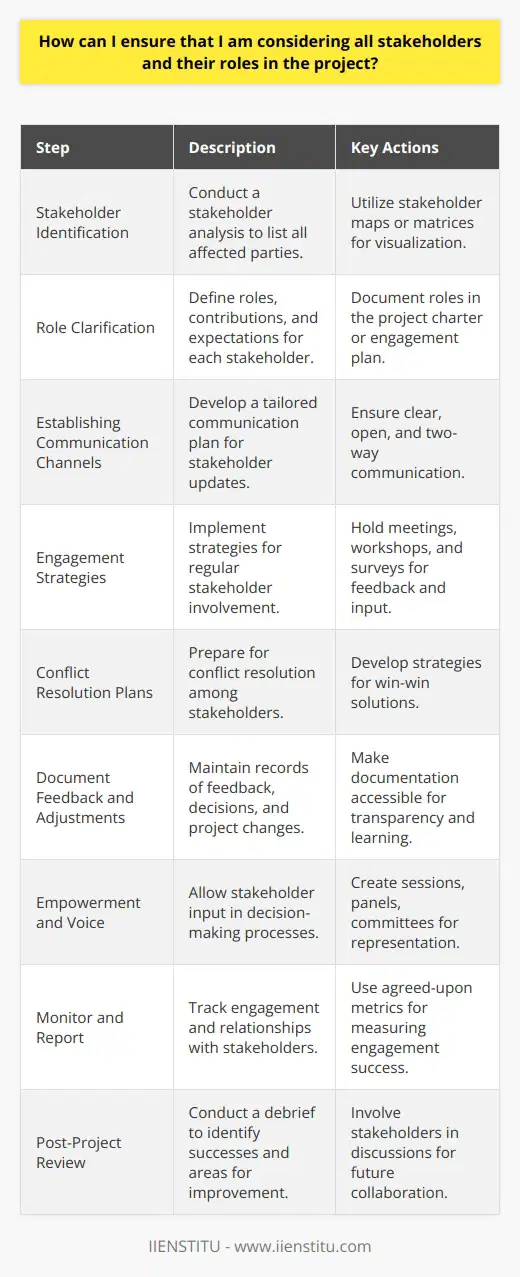
Why is it important to categorize stakeholders?
Importance of Categorization
Categorizing stakeholders plays a crucial role in the effective management and communication within an organization or a project. It allows organizations to understand and address the different needs, expectations, and concerns of various stakeholder groups.
Identification and Prioritization
Stakeholder categorization helps in identifying all the relevant parties involved or affected by a project or decision. This process ensures that no key stakeholder is overlooked. Additionally, it aids in prioritizing stakeholders based on their influence, interests, and importance.
Targeted Communication
Categorizing stakeholders facilitates targeted communication, enabling organizations to tailor messages and strategies to the specific needs and expectations of each group. This targeted approach helps to build strong, transparent relationships with stakeholders and to address potential issues proactively.
Resource Allocation
By understanding the differing priorities and interests of various stakeholder groups, organizations can allocate resources more effectively. This allows for the efficient distribution of time, energy, and funds, ensuring that stakeholder concerns are addressed appropriately and that projects progress smoothly.
Risk Management
Categorizing stakeholders plays an essential role in risk management. By understanding each group's concerns and interests, organizations can anticipate potential challenges, conflicts, or issues that may arise. This proactive approach helps to mitigate risks and ensure successful project execution.
Decision Making
Informed decision making is integral to organizational success. Categorizing stakeholders assists in understanding the perspectives and priorities of different groups, enabling organizations to make well-informed decisions that account for stakeholder expectations and concerns, consequently fostering social responsibility.
Conclusion
Categorizing stakeholders is essential to the effective management of an organization or project, contributing significantly to targeted communication, prioritization, resource allocation, risk management, and decision making. By addressing the diverse needs and expectations of various groups, organizations can foster stronger relationships, anticipate challenges, and ensure successful outcomes.
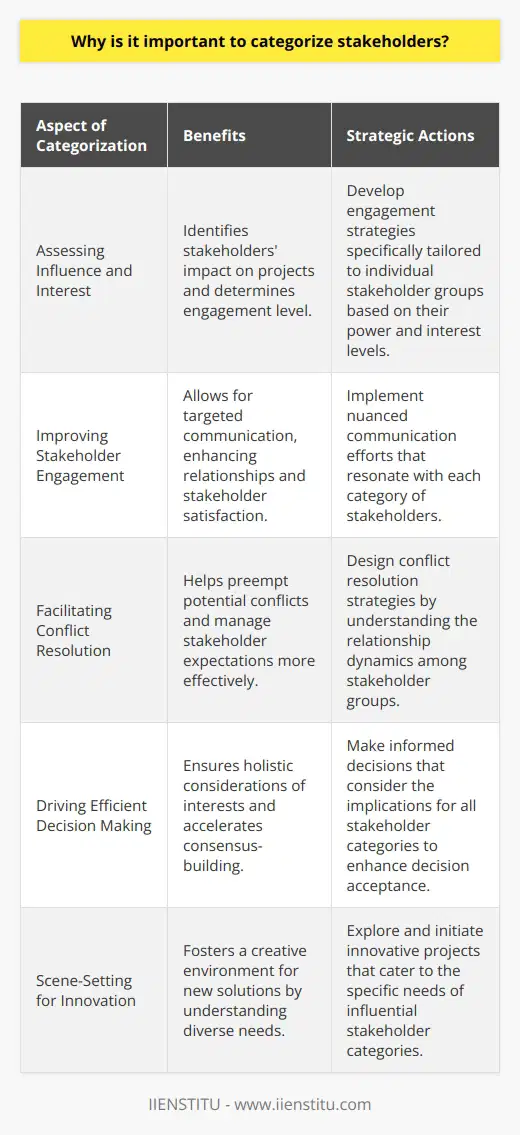
How do you categorize stakeholders in a project?
Identifying Stakeholder Categories
In the context of project management, stakeholders can be categorized based on their influence, interest, and contribution to the project. By adopting a systematic approach, project managers can improve stakeholder communication and minimize potential conflicts. The following sections discuss three key classification methods: power-interest, power-influence, and interest-influence grids.
Power-Interest Grid
The power-interest grid categorizes stakeholders based on their level of authority (power) and their personal or collective interest in the project's outcome. In this model, stakeholders are classified into four groups: high-power, high-interest; high-power, low-interest; low-power, high-interest; and low-power, low-interest. This method enables project managers to prioritize stakeholders and adopt tailored communication strategies.
Power-Influence Grid
Similar to the power-interest grid, the power-influence grid distinguishes stakeholders based on their authority and their capacity to influence the project. The main categories in this classification are: high-power, high-influence; high-power, low-influence; low-power, high-influence; and low-power, low-influence. This approach assists in identifying those stakeholders who can significantly impact the project's outcome and facilitates the development of appropriate stakeholder engagement plans.
Interest-Influence Grid
The interest-influence grid is a classification method focused on stakeholders' commitment to the project and their ability to influence its outcome. Four categories emerge from this framework: high-interest, high-influence; high-interest, low-influence; low-interest, high-influence; and low-interest, low-influence. By understanding each stakeholder's position in this grid, project managers can ensure that they are considered throughout the project lifecycle, and potential negative impacts are mitigated.
In conclusion, categorizing stakeholders using one or more of these grids facilitates targeted communication strategies and improved management of stakeholder relationships. By understanding stakeholders' interests, power, and influence, project managers can optimize stakeholder engagement, leading to greater project success.
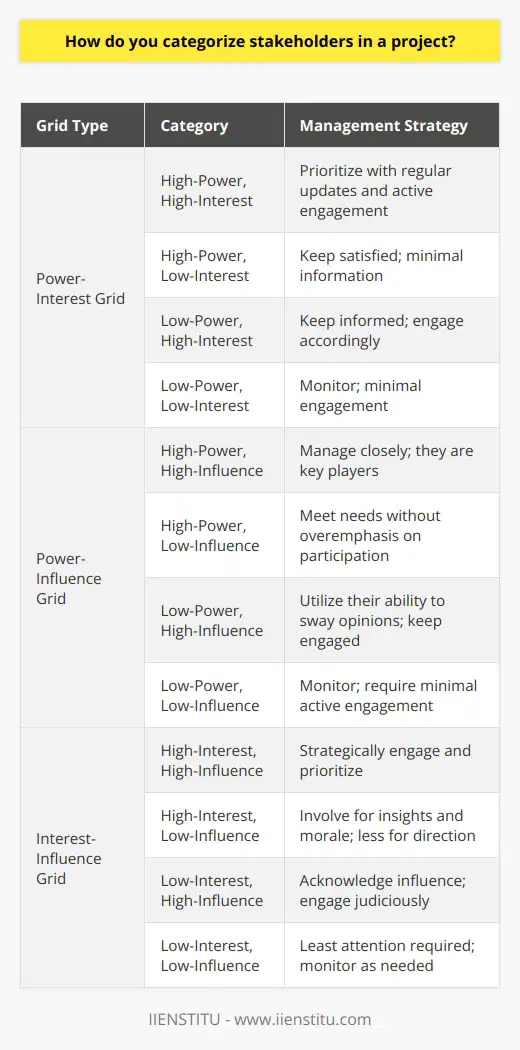
What are the key differences between the various stakeholder categories?
Stakeholder Categories Overview
Stakeholders can be broadly classified into four categories: internal, connected, external, and influencing stakeholders. This classification is based on the stakeholders' relationship to the organization, their level of influence, and the extent to which their interests are affected by the organization's decisions and actions.
Internal Stakeholders
Internal stakeholders include employees, managers, and executives who directly participate in the organization's decision-making and operational processes. Their key interests relate to compensation, job security, and career development, as well as the overall success of the organization.
Connected Stakeholders
Connected stakeholders comprise individuals and entities that have a direct relationship with the organization, usually as suppliers, customers, or business partners. These stakeholders have vested interests in the organization's performance, as it affects their own profitability, growth, and stability. For instance, suppliers depend on a steady demand for their products or services, while customers seek quality products, timely delivery, and responsive customer service.
External Stakeholders
External stakeholders, such as competitors, regulators, and the local community, do not have a direct relationship with the organization but are influenced indirectly by its actions. Competitors analyze the organization's market position and strategies, seeking opportunities for their own advantage. Regulators oversee the organization's compliance with laws and regulations, ensuring its actions do not negatively impact the broader public interests. The local community, on the other hand, is interested in the organization's contributions to social, economic, and environmental development.
Influencing Stakeholders
Influencing stakeholders are individuals or groups that can impact the organization's reputation and legitimacy, such as the media, industry associations, and activist organizations. These stakeholders may not be directly affected by the organization's decisions but can sway public opinion, generate support or opposition, and shape the organization's external environment. By monitoring the concerns and perceptions of influencing stakeholders, organizations can proactively manage their communication, image, and stakeholder relations.
In conclusion, recognizing and understanding the key differences between various stakeholder categories enable organizations to better identify, prioritize, and address the needs and expectations of these diverse influence groups. Fostering responsive relationships and open communications with stakeholders ultimately contributes to enhanced organizational performance, value creation, and sustainable development.
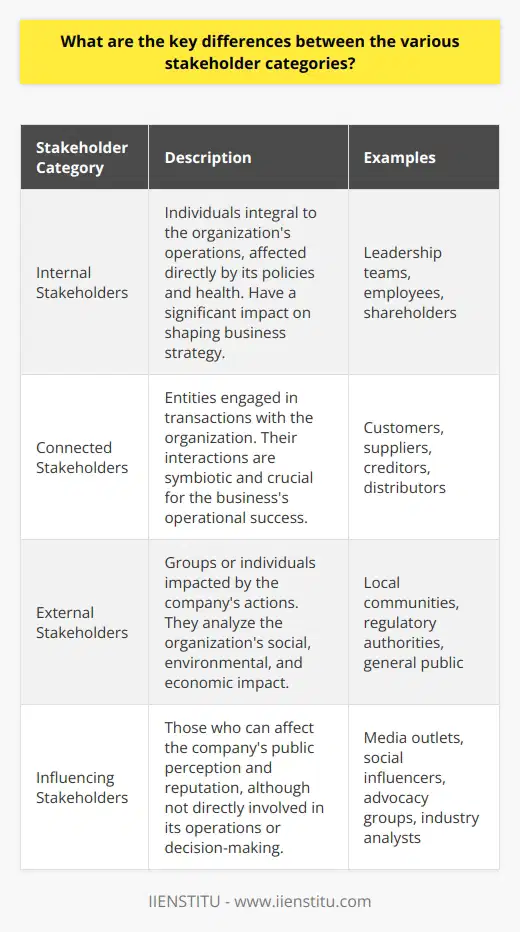
How do you categorize stakeholders in the context of project management?
Stakeholder Categorization Methods
In the context of project management, stakeholders can be categorized using various methods that help in understanding their roles, interests, and influence on the project. These categorization methods are essential for identifying the appropriate engagement and communication strategy for each stakeholder group.
Power-Interest Grid
The Power-Interest Grid is a popular tool for categorizing stakeholders based on their power over the project and their interest in its outcomes. In this method, stakeholders are plotted on a two-dimensional grid with axes representing power and interest. This results in four quadrants: high power-high interest, high power-low interest, low power-high interest, and low power-low interest. Project managers can use this grid to determine which stakeholders require the most attention and tailored communication strategies.
Three-Category Model
Another approach to stakeholder categorization is the Three-Category Model, which classifies stakeholders based on their impact on the project. This model divides stakeholders into primary, secondary, and key stakeholders. Primary stakeholders are those who are directly affected by the project, such as customers and end-users. Secondary stakeholders indirectly influence the project, such as regulatory bodies or competitors. Key stakeholders hold significant authority or knowledge about the project and can make or break its success, such as top management or expert consultants.
Project Lifecycle Stages
Stakeholders can also be categorized according to the project lifecycle stages they are most involved in or have the most significant influence. These stages include initiation, planning, execution, monitoring and controlling, and closing. Identifying stakeholders in this manner helps project managers ensure that appropriate communication, collaboration, and engagement occur at each stage of the project lifecycle.
Stakeholder Roles
A further method of categorization involves grouping stakeholders based on their roles within or outside the project. This classification includes internal and external stakeholders. Internal stakeholders are individuals or groups within the organization who are involved in the project or affected by its outcomes, such as project team members, functional managers, and executives. External stakeholders are those outside the organization, including suppliers, customers, regulatory bodies, and investors.
Conclusion
Effective stakeholder categorization is crucial for successful project management. Adopting one or more of these categorization methods allows project managers to better understand stakeholders, identify their needs and motivations, and develop targeted engagement and communication strategies. This strategic approach significantly increases the likelihood of project success and ensures that all stakeholders' interests are taken into consideration throughout the project's lifecycle.

What are the 4 stakeholder categories in a typical organizational setting?
Stakeholder Categories in Organizational Settings
Understanding Stakeholder Groups
A typical organizational setting involves four main categories of stakeholders. These groups include internal, external, major, and minor stakeholders. Each category plays a crucial role in determining an organization's direction, performance, and success. By comprehending these groups, decision-makers can efficiently manage relationships, communication, and resources to achieve desired outcomes.
Internal Stakeholders: Employees and Managers
Internal stakeholders are those who have a direct relationship with the organization, primarily by working for it. This group includes employees, managers, and executives. They play a central role in driving the organization's objectives forward by ensuring its day-to-day operation and long-term growth. Establishing healthy working conditions and empowering employees are some ways to encourage the internal stakeholders' support.
External Stakeholders: Customers, Suppliers, and Partners
External stakeholders are those who relate to an organization through a commercial or contractual basis. This group includes clients or customers, suppliers, and partners. They influence the demand for products and services, the organization's supply chain, and collaborations. Establishing positive relationships with external stakeholders can generate customer loyalty, improved supply chain efficiency, and fruitful partnerships.
Major Stakeholders: Shareholders and Investors
Major stakeholders are individuals or groups with significant financial stakes and direct influence on an organization's performance. This group includes shareholders who own stocks or have equity investments in the organization, and institutional investors who provide capital for the operation or growth. Engaging with major stakeholders is crucial, as they have a vested interest in the organization's successes, and their financial support could be a decisive factor in its sustainability and expansion.
Minor Stakeholders: Communities and Regulatory Agencies
Lastly, minor stakeholders are those indirectly affected by an organization's operations or have a relatively lower degree of influence. This group includes local communities where the organization operates, regulatory agencies like environmental or standards organizations, and potential clients. While minor stakeholders may not have a direct impact on the organization's bottom line, addressing their concerns and expectations can contribute to an organization's reputation and brand image.
In conclusion, by understanding and managing the relationships with internal, external, major, and minor stakeholders, organizations can considerably increase their chances of success. Proper communication, engagement, and alignment with these groups promote a collaborative environment, fostering growth and long-term stability within the organization.
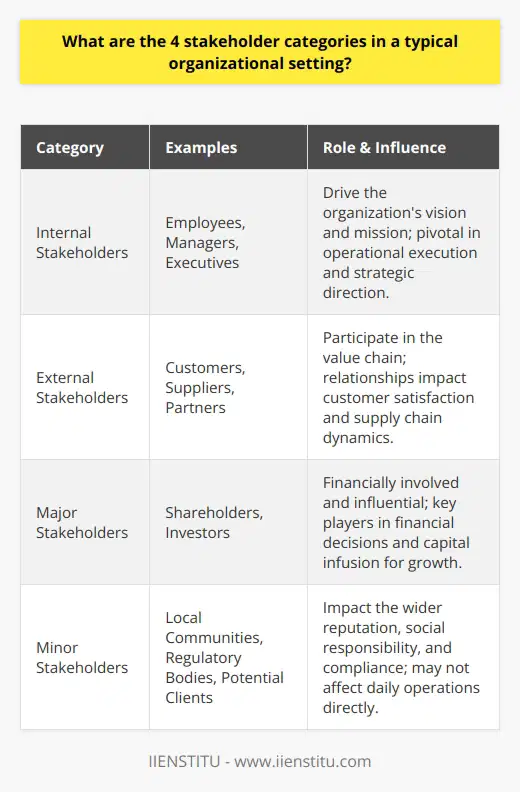
What are the five levels of stakeholders within an organization and why is it essential to understand their significance?
Stakeholder Hierarchy
In a modern organization, stakeholders can be categorized into five distinct levels: primary, secondary, tertiary, market, and non-market stakeholders. Recognizing and understanding the significance of each level is crucial for the organization's overall success and sustainability.
Primary Stakeholders
Primary stakeholders are the most critical group. They include employees, shareholders, customers, suppliers, and other parties directly impacted by the company's success or failure. Fostering relationships with primary stakeholders ensures the organization remains profitable, competitive, and sustainable.
Secondary Stakeholders
Secondary stakeholders constitute entities indirectly affected by the organization's financial decisions, such as competitors and trade associations. Understanding the motivations and concerns of secondary stakeholders allows a company to respond proactively to industry trends, mitigate risks, and uncover opportunities for collaboration and innovation.
Tertiary Stakeholders
Tertiary stakeholders refer to individuals or groups with remote yet relevant interest in the organization, such as local communities, the government, and NGOs. Maintaining open lines of communication with tertiary stakeholders showcases a commitment to responsible business practices and ensures compliance with relevant regulations.
Market Stakeholders
Market stakeholders encompass all individuals and organizations that impact or are influenced by the company's market activities, including financiers, regulators, and consumers. Monitoring market stakeholders' actions aids in identifying emerging industry patterns, potential risks, and business prospects.
Non-Market Stakeholders
Lastly, non-market stakeholders consist of individuals and entities not directly involved with the organization's market activities. They include media, activists groups, and general society. Building relationships with non-market stakeholders is essential in enhancing the organization's reputation, securing public support, and addressing any potential public relations concerns.
Conclusion
In summary, effective stakeholder management can lead to improved competitiveness, greater sustainability, and enhanced overall performance for an organization. By comprehending the differences between the five levels of stakeholders and addressing their specific needs, an organization can benefit from increased stakeholder satisfaction and improved strategic decision-making.
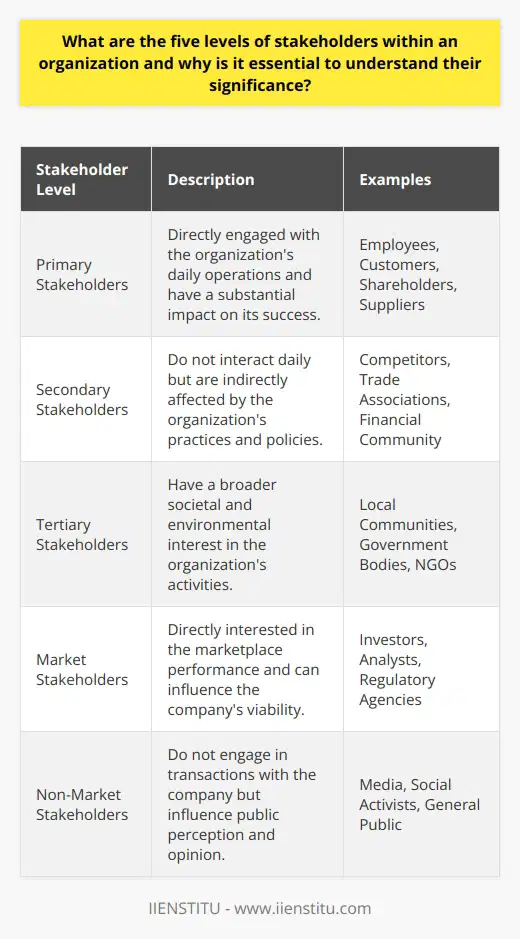
How do you categorize stakeholders in project management?
Categorization of Stakeholders in Project Management
Internal and External Stakeholders
In project management, stakeholders can be broadly classified into two categories: internal and external stakeholders. Internal stakeholders are individuals or groups within the organization, directly involved in the project or affected by its outcome. These may include project managers, team members, employees, top management, or functional departments, such as finance, human resources, and marketing. Their participation and support contribute to the project's success, and any dissatisfaction or conflicts among them could jeopardize the project's outcome.
Primary and Secondary Stakeholders
Moreover, stakeholders can be further distinguished as primary and secondary stakeholders based on their involvement and influence on the project. Primary stakeholders are those who directly affect or are affected by the project's outcome, such as clients, project managers, team members, suppliers, and end-users. They possess a significant degree of power and interest in the project and need to be managed carefully to ensure their expectations and requirements are met.
On the other hand, secondary stakeholders are not directly involved in the project execution but may still have an interest in its outcome. Such stakeholders might include competitors, regulators, industry associations, or local communities. Although their influence may be less significant than the primary stakeholders, their concerns and input should not be neglected in the project management process.
Voluntary and Involuntary Stakeholders
Another way to categorize stakeholders is distinguishing them as voluntary and involuntary stakeholders. Voluntary stakeholders choose to associate themselves with the project and can withdraw or modify their involvement according to their preferences. Examples include investors, partners, or suppliers. In contrast, involuntary stakeholders have no choice in their relationship with the project as the project impacts them directly or indirectly, such as local communities, customers, or regulatory bodies. It is essential to recognize and address the concerns of both the voluntary and involuntary stakeholders, ensuring that their interests are taken into consideration in project decision-making.
In conclusion, effective stakeholder categorization and management are critical components of successful project management. By identifying stakeholders as internal or external, primary or secondary, and voluntary or involuntary, project managers can better understand their concerns, expectations, and the extent of their influence, enabling them to devise tailored strategies for engaging and managing stakeholders throughout the project lifecycle.
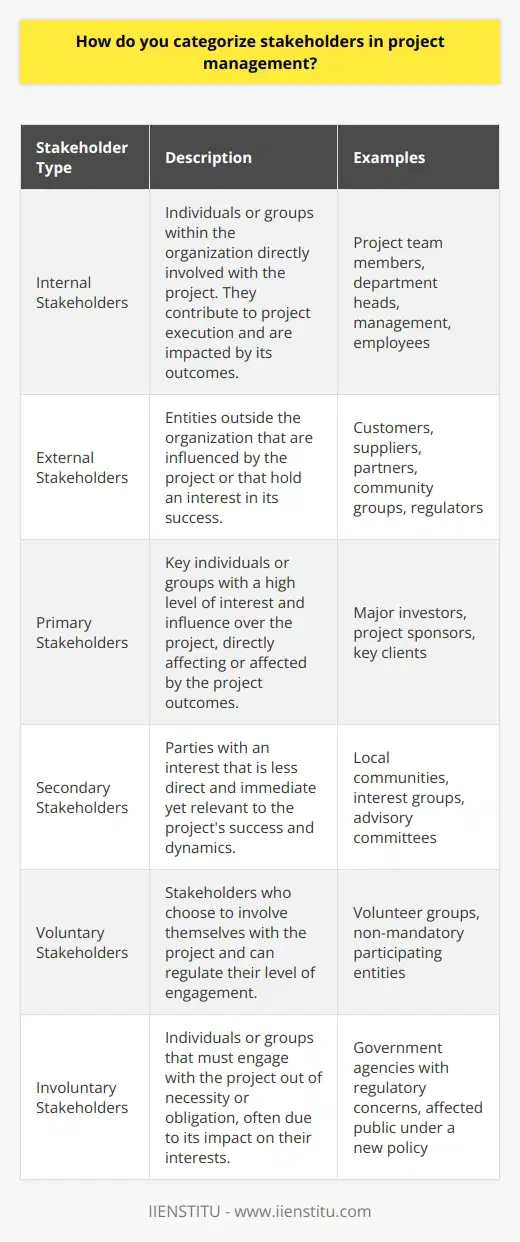
What is one way to classify your stakeholders?
Stakeholder Classification by Power and Interest
One effective way to classify stakeholders is by assessing their power and interest in relation to the blog post. This approach allows for a better understanding of the diverse group of individuals or entities that may be affected by, or influence, the blog's content and objectives.
Power Assessment
Firstly, determine the power that each stakeholder possesses. This refers to their authority, resources, or influence over the blog's outcomes. Stakeholders with high power may include sponsors, advertisers, or key influencers in the blog's niche. Conversely, stakeholders with lower power may be casual readers or contributors with minimal sway over the blog's direction.
Interest Evaluation
Next, evaluate the level of interest each stakeholder holds in the blog's success or overall objectives. Highly interested stakeholders may be actively involved in the blog's development and invested in its growth. These individuals or entities could be content creators, editors, or engaged readers. On the other hand, stakeholders with lower interest levels might demonstrate minimal engagement or passive participation in the blog.
Stakeholder Quadrants
Using the assessments of power and interest, stakeholders can be placed into four distinct quadrants:
High Power, High Interest: These stakeholders are critical to the blog's success, as they have both the resources and motivation to affect outcomes. Engaging and prioritizing them is crucial to maintaining the blog's growth and stability.
High Power, Low Interest: Though these stakeholders have the capacity to influence the blog, their low interest means they are less likely to do so. Monitoring and engaging with them occasionally can ensure they do not become potential obstacles to the blog's goals.
Low Power, High Interest: This group includes avid readers and followers who engage with the blog's content but have little power to shape its direction. Communicating with these stakeholders can provide valuable feedback and foster a sense of community.
Low Power, Low Interest: These stakeholders have minimal influence and interest in the blog. While they may not require the same level of attention as other quadrants, monitoring their activity can prevent unexpected disruptions.
In conclusion, classifying stakeholders based on power and interest can greatly inform and enhance a blog's engagement strategies. By understanding the varying levels of influence and motivation, blog owners can effectively prioritize and address the needs of different stakeholder groups, ultimately benefiting the blog's success and growth.
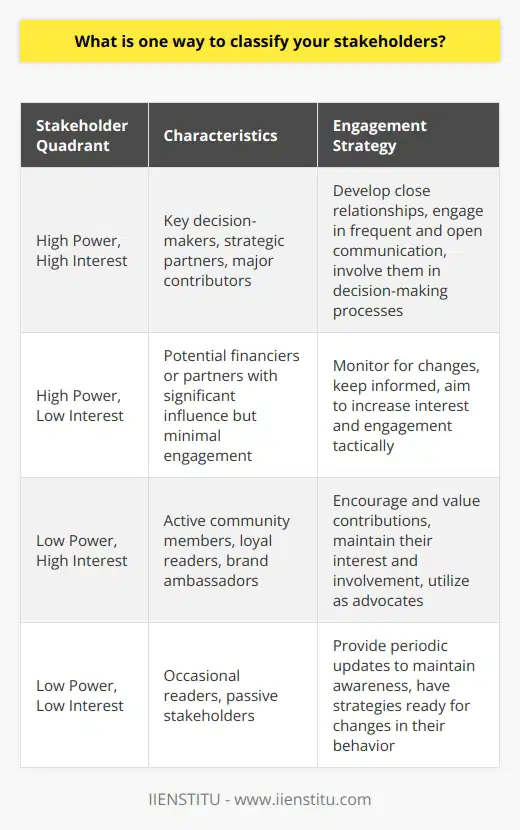
What are the four categories of stakeholders?
Stakeholder Categories in Blogging
Identifying Stakeholders
Stakeholders play a crucial role in a blog's success, as they directly or indirectly influence its growth and sustainability. Broadly, stakeholders can be divided into four categories: primary, secondary, functional, and strategic. Each group possesses unique characteristics and offers different perspectives to the blogger.
Primary Stakeholders
Primary stakeholders hold a direct and immediate interest in the blog's content, performance, and outcomes. They comprise the blog's core audience, including dedicated readers, subscribers, and social media followers. Catering to their needs and expectations is vital for retaining readership and maintaining the blog's popularity.
Secondary Stakeholders
Secondary stakeholders have a more indirect relationship with a blog, as they are usually involved in the blog's operational processes. Examples include advertisers, sponsors, and affiliates who financially support the blog. Their input could impact the blog's content, layout, appearance, and promotional activities, making their involvement crucial for the blog's financial sustainability.
Functional Stakeholders
Functional stakeholders are individuals or organizations that provide essential blogging resources, such as IT services, web hosting, and content management tools. They ensure the smooth functioning and maintenance of the blog. For instance, a web developer might identify and fix technical issues, while a search engine optimizer improves the blog's online visibility.
Strategic Stakeholders
Lastly, strategic stakeholders are those who have the power to determine and shape the blog's overall direction and long-term goals. They might be mentors, influencers, or industry experts who offer guidance and insights to help the blogger make informed decisions. These stakeholders provide valuable advice, making it crucial for the blogger to maintain a strong relationship with them.
In conclusion, understanding and engaging with the four categories of stakeholders – primary, secondary, functional, and strategic – is instrumental in ensuring a blog's growth and sustainability. By addressing their needs and concerns, bloggers can not only improve their content but also ensure their blog continues to thrive in the competitive online world.
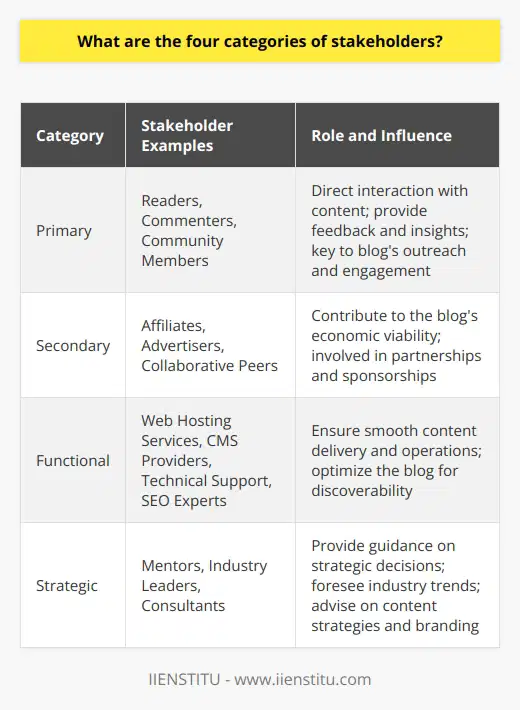
How do you categorize stakeholders in the context of project management?
Categorizing Stakeholders in Project Management
**Internal and External Stakeholders**
Within the context of project management, stakeholders can be broadly categorized into two main groups: internal and external stakeholders. Internal stakeholders refer to individuals or groups within the organization implementing the project, while external stakeholders pertain to those outside the organization but who have interests or may be affected by the project.
**Influence and Interest Matrix**
To further categorize stakeholders, project managers often use the influence and interest matrix. This matrix classifies stakeholders based on their level of interest in the project's outcome and their level of influence over the project. By using this matrix, project managers can better assess stakeholder needs, prioritize communication, and allocate resources effectively.
**Four Categories of Stakeholders**
Based on their influence and interest in a project, stakeholders may fall into one of four categories: high influence-high interest, high influence-low interest, low influence-high interest, and low influence-low interest.
*High Influence-High Interest:* These stakeholders have both strong influence over project decisions and high interest in the project's outcomes. This group, which may include senior management and key clients, should receive close attention and regular communication to ensure their expectations are met and their concerns addressed.
*High Influence-Low Interest:* Stakeholders in this category have significant decision-making power or control over project resources but may have limited interest in the project itself. This group, which may include department heads or financial sponsors, should be kept informed and engaged to maintain support and ensure project success.
*Low Influence-High Interest:* These stakeholders are those who may not have direct control over the project but are highly interested in its outcomes. Such stakeholders, such as end-users or local community members, can offer valuable insights and perspectives that improve project outcomes. Project managers should engage them through consultation and information-sharing.
*Low Influence-Low Interest:* Lastly, these stakeholders have limited influence and interest in the project. However, they should not be ignored entirely as their interest or influence might change over time. Periodic communication in the form of updates or briefings may be appropriate for this group.
In conclusion, categorizing stakeholders in project management is an essential step in understanding their needs, interests, and influence on project outcomes. By using the influence and interest matrix, project managers can effectively engage and manage stakeholders, ultimately contributing to the project's success.
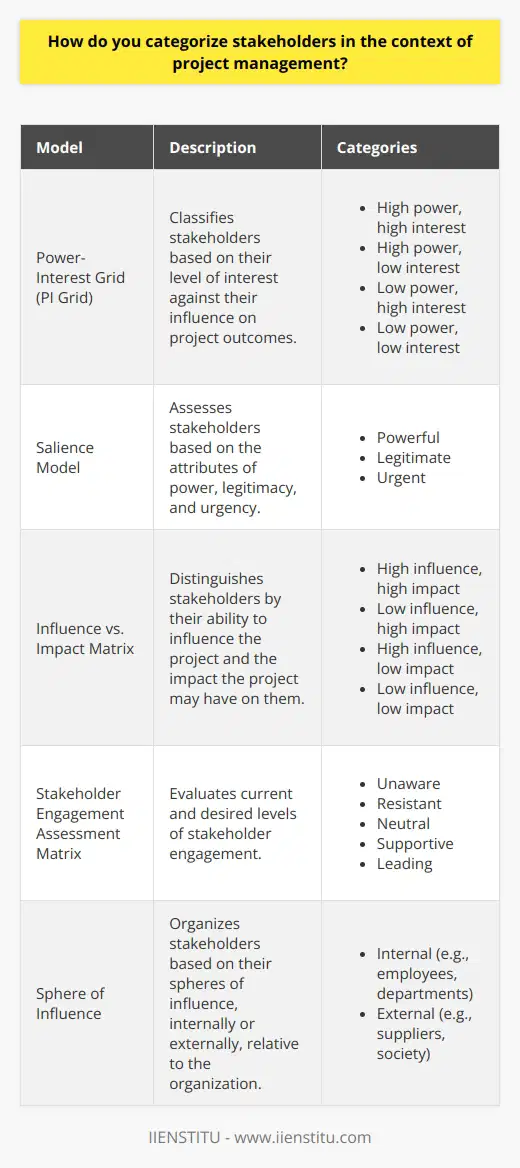
What are the key distinctions between the various stakeholder categories in an organizational setting?
Stakeholder Categories
In an organizational setting, stakeholders can be categorized into three main groups: internal, external, and connected. These categories illustrate the key distinctions between the various stakeholder types, mainly in terms of their relationship with the organization and their vested interests.
Internal Stakeholders
Internal stakeholders primarily consist of entities and individuals within the organization, such as employees, managers, and owners. Their interests are directly related to the organization's performance, as they are significantly impacted by its success or failure. For example, employees may seek job security and career advancement, while management seeks growth and profitability. Internal stakeholders often possess extensive knowledge of the organization's operations and are thus influential contributors to decision-making processes.
External Stakeholders
The second category encompasses external stakeholders who do not actively participate in the organization's daily activities, but may be affected by its decisions. Such stakeholders include customers, suppliers, competitors, and regulators. Customers, for instance, may desire high-quality products and services at competitive prices, while suppliers seek profitable business opportunities and consistent demand for their offerings. These stakeholders can exert influence on an organization in various ways, such as affecting its market position, financial stability, and public perception.
Connected Stakeholders
Lastly, connected stakeholders represent the intersection between internal and external categories, as they maintain a direct relationship with the organization while remaining partially independent. Examples include investors, business partners, and key contractors. These stakeholders may have vested interests that partially align with the organization's objectives, such as investors seeking a return on investment or business partners engaging in mutually beneficial ventures. Connected stakeholders may provide valuable resources and support, while simultaneously expecting the organization to uphold certain standards or deliver specific outcomes.
In conclusion, understanding the key distinctions between internal, external, and connected stakeholder categories enables organizations to effectively engage with these diverse groups. Recognizing their unique interests, perspectives, and influence can optimize decision-making processes, strengthen relationships, and ultimately enhance overall organizational performance.
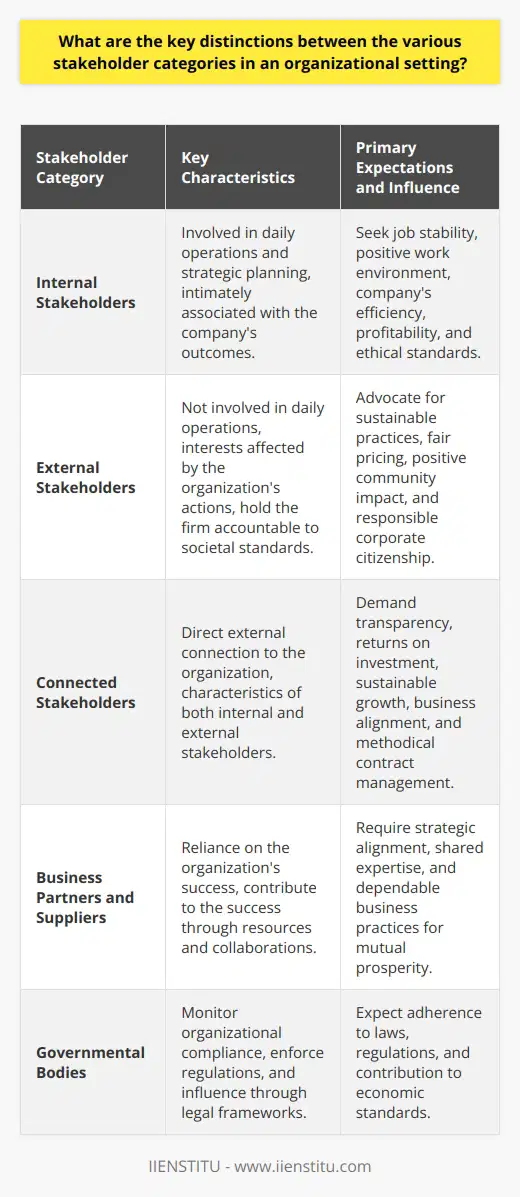
Why is it crucial to recognize and categorize stakeholders during the early stages of project planning?
Identification of Stakeholders
Recognizing and categorizing stakeholders during the early stages of project planning is crucial for several reasons. First, it ensures that all potential stakeholders' interests, needs, and expectations are considered, which ultimately results in a better project outcome. The identification of key stakeholders helps in tailoring the project's approach and establishing effective communication channels, leading to better decision-making processes.
Inclusive Decision-Making
With a clear understanding of the diverse perspectives and priorities of different stakeholders, project planners can make more informed and inclusive decisions. This not only aligns the project with the organization's strategic goals but also fosters stronger collective support from all involved parties. By including stakeholders from the start, planners can avoid potential conflicts and delays that may arise due to neglected stakeholder concerns.
Resource Allocation and Prioritization
Another reason to recognize and categorize stakeholders early is for effective resource allocation and prioritization. Understanding who the primary and secondary stakeholders are helps project managers allocate resources more strategically and ensures that efforts are concentrated on the most significant impact areas. Additionally, a clear understanding of stakeholder categorization can help in setting project priorities, allowing managers to create realistic timelines and effectively manage scope.
Risk Management and Mitigation
Proactively identifying stakeholders and their involvement in the project also aids in risk management and mitigation. Early engagement with stakeholders enables project planners to identify potential risks and develop appropriate mitigation strategies before they escalate into significant issues. By addressing risk factors early in the planning process, planners can minimize their impact on the project's success.
In conclusion, recognizing and categorizing stakeholders during the early stages of project planning significantly contributes to the success of a project. It allows for more inclusive decision-making, efficient resource allocation, prioritization of efforts, and proactive risk management. This comprehensive approach results in more successful projects that meet the needs and expectations of all stakeholders involved.

How do you categorize stakeholders in project management and why is this categorization essential for effective communication?
Stakeholder Categorization Approaches
In project management, stakeholders can be categorized using multiple approaches, including power-interest, influence-impact, and attitude-based grids. These categorization methods help in understanding the stakeholders' priorities, interests, and influence on the project.
Role of Categorization in Effective Communication
This categorization is essential for effective communication because it allows project managers to tailor their communication strategies to address the needs, expectations, and concerns of each stakeholder category. By understanding the stakeholders' positions, project managers can determine the appropriate level of detail, frequency, and mode of communication for each group.
Power-Interest Grid
The power-interest grid is a popular method for classifying stakeholders according to their influence on the project and their interest in its outcomes. This grid consists of four quadrants: high power-high interest, high power-low interest, low power-high interest, and low power-low interest. Based on their placement within the grid, project managers can devise suitable communication strategies to engage each stakeholder group effectively.
Influence-Impact Grid
The influence-impact grid focuses on the stakeholders' ability to affect project outcomes and the potential effects of the project on them. The grid has four parts: high influence-high impact, high influence-low impact, low influence-high impact, and low influence-low impact. Being aware of these distinctions allows project managers to prioritize stakeholder engagement efforts and address the most critical concerns efficiently.
Attitude-Based Grid
Using an attitude-based grid, stakeholders are sorted according to their attitudes towards the project: supportive, neutral, or resistant. This categorization helps project managers identify allies and potential opponents, assess the underlying reasons for their attitudes, and design targeted communication strategies to reinforce support or mitigate resistance.
Conclusion
Stakeholder categorization plays a crucial role in effective communication within project management. By employing methods such as power-interest, influence-impact, and attitude-based grids, project managers can tailor their communication strategies to cater to the needs, expectations, and concerns of various stakeholders. This customized approach fosters better relationships, enhances collaboration, and ultimately contributes to the successful completion of the project.
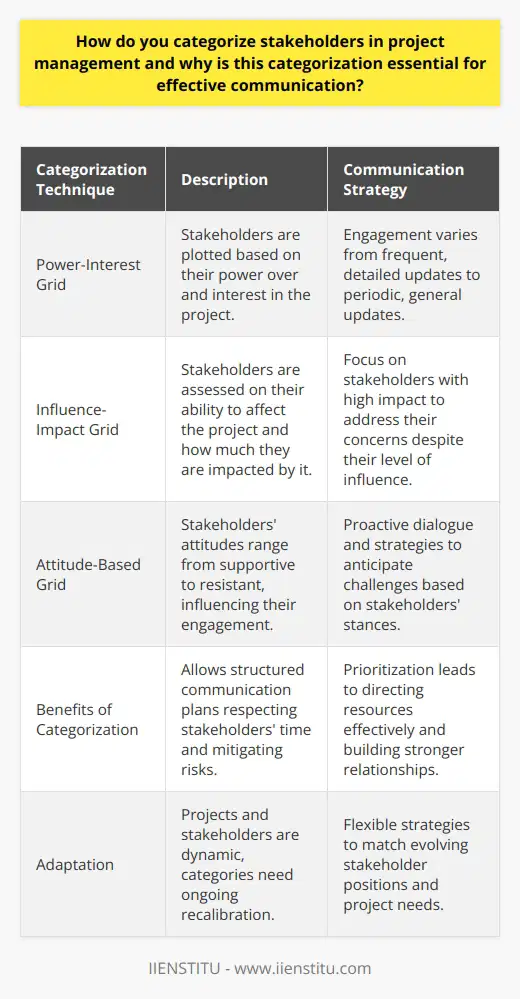
What are the four categories of stakeholders and how do their interests and influence levels differ from each other?
Categories of Stakeholders
The four categories of stakeholders can be broadly classified as internal, connected, external, and peripheral stakeholders. Each category has unique interests and varying levels of influence depending on the context of a particular organization or project.
Internal Stakeholders
Internal stakeholders include an organization's employees, managers, and board members. Their interests are directly aligned with the organization's success as it directly impacts their job security, income, and career growth. They possess high levels of influence as they make decisions and actively participate in the organization's operations.
Connected Stakeholders
Connected stakeholders consist of parties such as suppliers, investors, and customers, who have a direct relationship with the organization. Their interests are tied to the organization's ability to meet their needs, including steady supply chains, returns on investment, and product satisfaction. Though not as influential as internal stakeholders, they can exert considerable influence on the organization through their purchasing and investment decisions.
External Stakeholders
External stakeholders include regulatory bodies, industry associations, and local communities that, although not directly involved in the organization's operations, can influence its actions. They possess varying degrees of influence, depending on legal authority and public opinion. Their interests lie in the organization's compliance with industry standards, adherence to regulations, and reputation within the community.
Peripheral Stakeholders
Peripheral stakeholders are those that have no immediate connection to the organization but may still be affected by its actions or decisions. These include media, competitors, and other indirect stakeholders. Their interests often revolve around newsworthy activities and market trends, affecting the organization's reputation and competitiveness. Although they generally have low levels of influence, in specific situations, they can significantly impact the organization's success or failure.
In conclusion, there are four main categories of stakeholders, each with differing interests and influence levels. The interests of internal and connected stakeholders are more closely aligned with the organization's success, while external and peripheral stakeholders focus more on regulatory compliance and reputation. The level of influence depends on the stakeholder's direct involvement in the organization's operations and its ability to impact its decisions and actions.
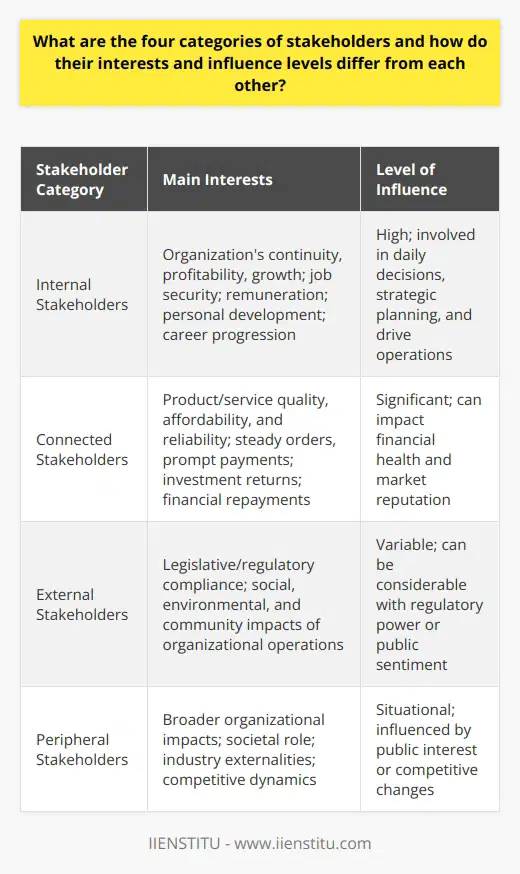
Why is it important to categorize stakeholders and what potential issues may arise if stakeholders are not properly categorized?
Stakeholder Categorization: A Critical Step
Categorizing stakeholders is essential for effectively managing relationships within an organization, enabling managers to prioritize actions and allocate resources appropriately. A well-defined categorization process enhances collaboration, communication, and the decision-making process. Failure to accurately categorize stakeholders can lead to detrimental consequences such as inadequate decision-making, conflicting interests, and reduced stakeholder engagement.
Efficient Resource Allocation
One of the primary reasons for categorizing stakeholders is to allocate resources effectively. An organization's resources, including time, money, and personnel, are limited; hence, it is crucial to carefully allocate these resources based on the significance and influence of the stakeholders. Proper categorization helps to identify the most influential stakeholders, enabling organizations to prioritize their needs and build strong working relationships with them.
Enhanced Collaboration and Communication
Categorizing stakeholders also plays a crucial role in facilitating collaboration and communication within an organization. By recognizing the different needs and goals of stakeholders, managers can tailor communication strategies to address these unique interests, promoting better understanding and cooperation among diverse stakeholder groups. This leads to a more inclusive and transparent communication process, ultimately fostering trust and collaboration within the organization.
Effective Decision-Making Process
Moreover, stakeholder categorization is vital in the decision-making process. It assists organizations in identifying the stakeholders directly affected by a particular decision, as well as those who can influence the decision-making process. This ensures that decisions are made considering diverse opinions and views, resulting in more comprehensive and equitable outcomes. Additionally, a more collaborative decision-making process enhances stakeholder buy-in, which is imperative for the long-term success of any project or initiative.
Potential Issues from Inadequate Categorization
Failing to accurately categorize stakeholders can have adverse consequences, such as:
Ineffective decision-making: Inadequate stakeholder categorization may lead to a lack of diverse perspectives during the decision-making process, resulting in decisions that may not cater to the needs of all stakeholders, creating dissatisfaction and conflict.
Conflicting interests: Not categorizing stakeholders properly can cause a misalignment of interests, leading to conflicts and potentially hindering the organization's progress.
Reduced stakeholder engagement: Stakeholders who feel their opinions are not valued or considered may become disengaged from the project, which can negatively impact the overall success of the project or initiative.
In conclusion, stakeholder categorization is critically important for effective stakeholder management, enabling organizations to allocate resources efficiently, foster better communication and collaboration, and make informed decisions. Neglecting this crucial step can result in a host of negative consequences, emphasizing the importance of thorough stakeholder categorization in any organization.
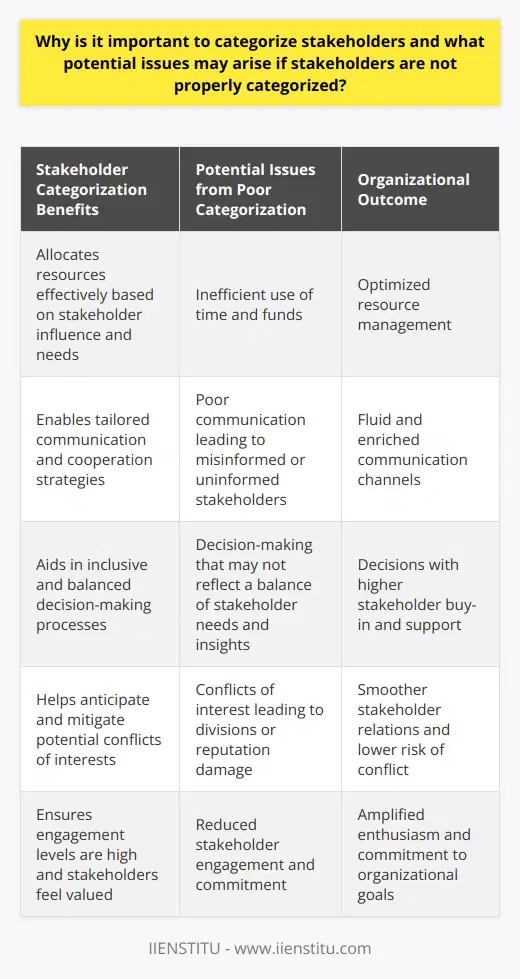
How do you categorize stakeholders in the context of project management, and what advantages does this categorization offer for achieving project success?
Categorization of Stakeholders in Project Management
In project management, we can categorize stakeholders in various ways. These divisions aim to improve the communication and engagement process.
Primary and Secondary Stakeholders
One basic categorization entails dividing stakeholders into primary and secondary. Primary stakeholders bear directly on the project's success or failure. Secondary stakeholders, on the other hand, indirectly influence the project outcome.
Internal and External Stakeholders
Another useful dichotomy separates stakeholders into internal and external groups. Internal stakeholders typically consist of team members or executives, while external stakeholders might include clients or public authorities.
Efficiency through Categorization
This categorization offers various benefits. It improves efficiency by fostering targeted communication. This pinpoint engagement strategy ensures each group gets relevant information, reducing miscommunication risks.
Building Positive Relationships
Categorization also aids in building positive relationships with stakeholders. By understanding their needs and interests, we can tailor engagement strategies. This, in turn, encourages trust and collaboration, which are crucial for project success.
Risk Management
Moreover, categorization helps in risk management. By recognizing the potential impact of different stakeholders, we can better anticipate and address potential barriers or challenges.
Improved Decision Making
Finally, understanding stakeholder categories contributes to decisions that align with stakeholder expectations, minimizing resistance and speeding up project progress. Consequently, categorization increases the likelihood of project success through improved communication, risk management, and decision-making.
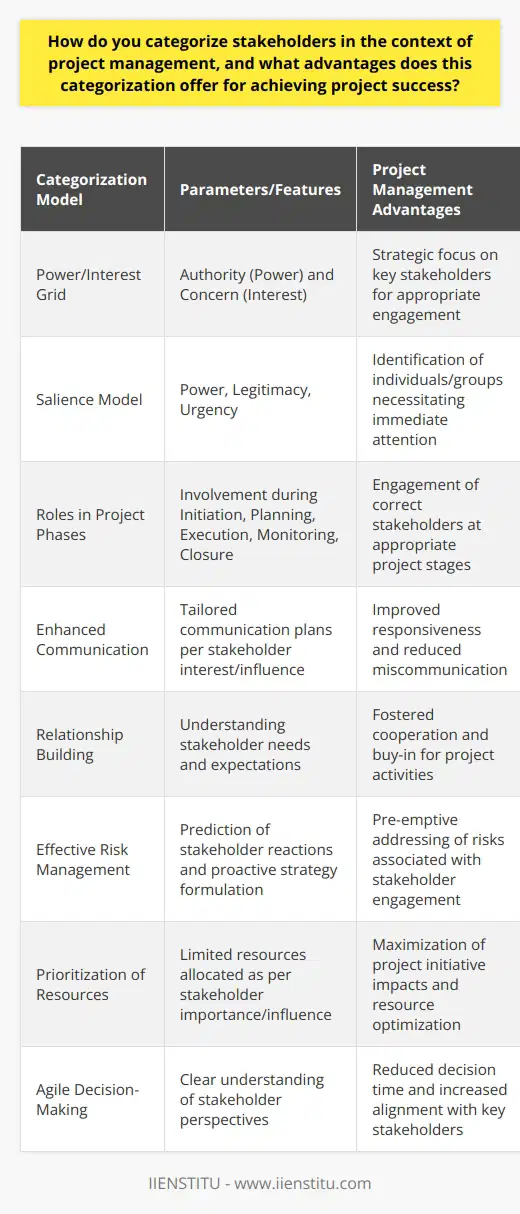
Why is it important to categorize stakeholders, and what are the potential consequences of failing to accurately identify and classify key stakeholders?
Significance of Stakeholder Categorization
Categorizing stakeholders holds paramount importance in achieving business objectives. This classification helps in understanding their needs, interests, and influence effectively. A clear comprehension of stakeholder dynamics enables strategic planning and fosters stronger relationships. Understanding what stakeholders prioritize, and in which area they can influence, thus, becomes crucial for driving organizational growth.
Potential Consequences of Inaccurate Stakeholder Classification
Failure in accurate identification and classification of stakeholders could lead to critical setbacks. The incorrect classification may result in overlooking important stakeholder groups, leading to grievances, protests, or opposition to business decisions. Misclassification or oversight can also jeopardize stakeholder buy-in, thereby undermining key initiatives, project implementations, or policy changes.
Role of Stakeholders in Decision Making
Inaccurate stakeholder identification can impact decision-making processes. By excluding key stakeholders, organizations risk making decisions that lack broader support and acceptance. Beneficial collaborations may be missed, and relationships with significant stakeholder groups could be strained.
Implications for Strategic Planning
Strategic planning can also suffer from inaccurate stakeholder identification. Organizations could miss key insights from pivotal stakeholders, leading to flawed strategies. This could result in financial losses, reputational damage, and lost opportunities for growth or improvement.
In conclusion, the categorization of stakeholders is a step that businesses cannot afford to overlook. A well-structured, meticulous approach towards stakeholder identification and classification can significantly enhance strategic decision-making capabilities and contribute to the overall success and sustainability of an organization.
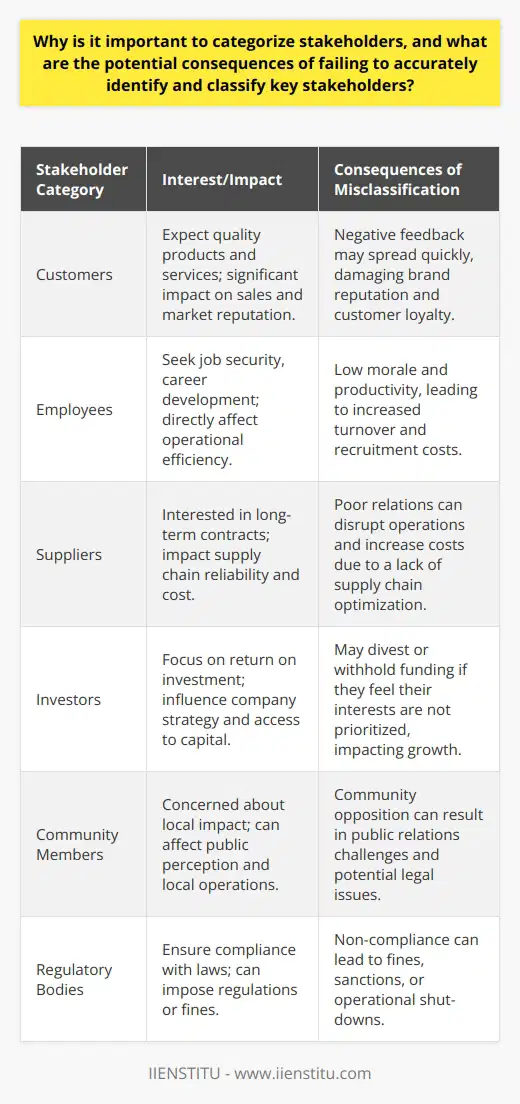
What are the four categories of stakeholders, and how can understanding these categories assist in planning and executing effective communication strategies for each group?
Four Stakeholder Categories
Stakeholders categorize into four: internal, connected, external, and influential. Understanding these categories aids in planning and executing effective communication strategies for each group.
Internal Stakeholders
Internal stakeholders consist of individuals within an organization. These may include employees, owners, and board members. Knowledge of this group offers insights into the right communication channels, often through team meetings, internal newsletters or emails.
Connected Stakeholders
Connected stakeholders have direct links with an organization, like suppliers and customers. Fostering good relations necessitates open dialogue. Communication here may involve regular updates, customer service interactions and direct feedback mechanisms.
External Stakeholders
External stakeholders have no direct link to the organization, yet, their actions may affect it indirectly. They may include the media, government bodies, and the general public. Effective communication involves clear public relations strategies and maintaining good media relations.
Influential Stakeholders
Lastly, influential stakeholders include policymakers or industry thought leaders. They can affect the organization's reputation and stability. Clear communication ensures alignment with industry expectations and standards. It may take form via policy updates, press releases, and social media interactions.
Understanding these categories is pivotal for a comprehensive and effective communication strategy. With this understanding, an organization can tailor messages for each group, using preferred channels, thus enhancing stakeholder relations.

How do you categorize stakeholders in the context of project management, and what are the main criteria used for this classification?
Stakeholder Categories in Project Management
Project management acknowledges the importance of stakeholders. You can primarily categorize them into three groups: internal, external, and external operational.
Internal Stakeholders
Internal stakeholders comprise individuals or groups within the project's executing organization. Often, they include project team members, project managers, and executives. Their interests lie in the project's success as it directly impacts the organization.
External Stakeholders
External stakeholders are those not directly involved in the organization's operational activities. They may include government bodies, regulatory authorities, or residents near the project site. These stakeholders' concerns can largely influence the project's planning and execution, making their consideration vital.
External Operational Stakeholders
External operational stakeholders, although external to the organization, play a direct role in the project operations. These may include vendors, suppliers, or contract workers. Their active participation in the project execution makes their classification important.
Criteria for Stakeholder Classification
The classification of stakeholders primarily relies on two main criteria: power and interest.
Power
Power herein refers to a stakeholder's ability to influence the project's direction or outcomes. Those with more power often require more attention and engagement.
Interest
Interest refers to how much the project's outcomes will affect the stakeholder's position. Managing stakeholders with high interest becomes a priority as they are more likely to engage actively in the project.
Thus, understanding stakeholders and classifying them based on their impact and influence plays a key role in successful project management. This categorization affords a balanced approach, managing the expectations and needs of all key project players.
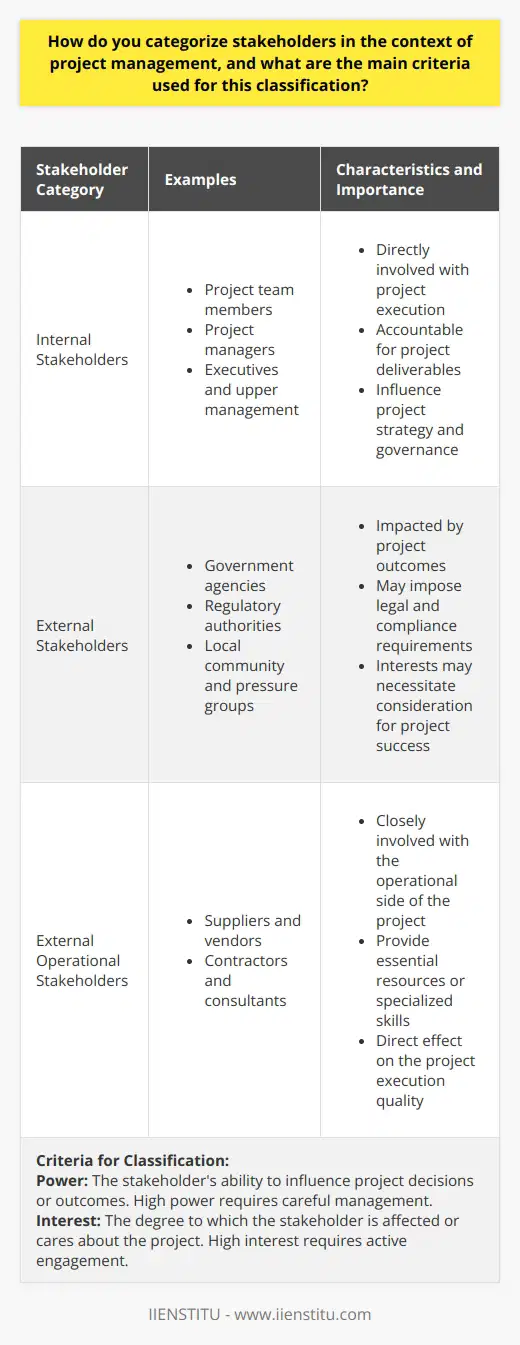
What are the two main ways to classify stakeholders, and how do these methods assist in understanding their roles and influence within a project?
Classifying Stakeholders Through Interest and Power
Scholars often classify stakeholders using two key dimensions: interest and power. Stakeholders with high interest are those who care deeply about the project's outcome, while those with high power can significantly influence the project’s course.
Understanding Stakeholder Interest
This classification aids in understanding the stakeholders' roles within a project. By identifying the highly interested stakeholders, project managers can better anticipate who will actively support or resist the project based on how it aligns with their interests. This knowledge assists the project team in planning their communication and engagement strategies to enhance support and manage resistance.
Grasping Stakeholder Power
On the other hand, classifying stakeholders based on power reveals those capable of affecting project outcomes, whether through authorizing resources, influencing decision-making, or controlling critical dependencies. Identifying these individuals or groups allows project managers to involve them at appropriate stages of the project to obtain their buy-in, mitigate risks, and leverage their influence to further the project’s objectives.
Project Management: A Holistic View
Moreover, this dual perspective – interest and power – offers a holistic view of the stakeholder landscape. It assists in discerning high-priority stakeholders (high interest and power) who require close management, and those requiring less attention such as low-interest, low-power stakeholders. Hence, this results in more effective stakeholder management, increasing the project's chances for success.
In conclusion, classifying stakeholders based on interest and power is a valuable approach in project management. It provides insights into stakeholders' roles and influence within a project, aiding in improved communication, enhanced stakeholder engagement, risk mitigation, and ultimately, successful project outcomes.
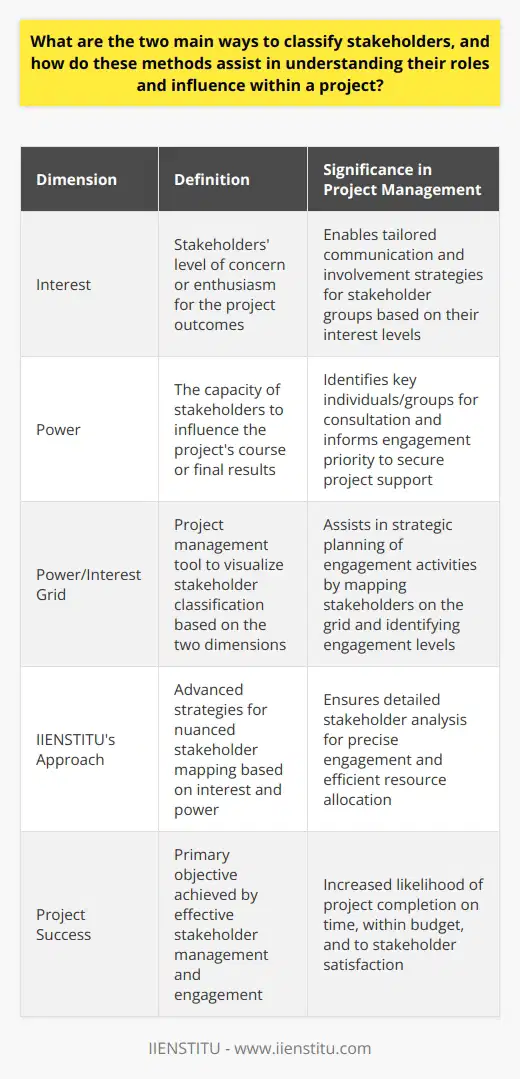
Why is it important to categorize stakeholders, and how does this classification facilitate the development of targeted communication and engagement strategies?
Significance of Stakeholder Categorization
The categorization of stakeholders proves to be a critical component for the successful functioning of a business. It enables companies to understand the diverse opinions and needs of people directly or indirectly associated with their activities.
Role in Strategy Formulation
This classification prompts the identification of key stakeholders who maintain a significant impact on the business operations. It influences the creation of specific communication and engagement strategies aligning with the attributes and interests of these stakeholders.
Understanding Stakeholder Interests
Categorization helps unearth the underlying interests, expectations, and potential sources of conflict among stakeholders. This insight further assists in devising stakeholder management strategies that ensure all stakeholders' needs are adequately met.
Enhancement of Communication
Stakeholder categorization paves the way for building effective communication channels. Businesses can tailor their messaging in accordance with the key characteristics of each stakeholder group, ensuring the message resonates with them.
Strengthening Stakeholder Engagement
Stakeholder categorization aids in designing targeted engagement strategies. It encourages broader participation and fosters a sense of ownership among stakeholders, thereby enhancing their loyalty towards the business.
In summary, categorizing stakeholders enables businesses to decipher the intricate dynamics of stakeholder relations, thereby fostering superior communication, stakeholder engagement, and ultimately propelling sustainable business growth.
